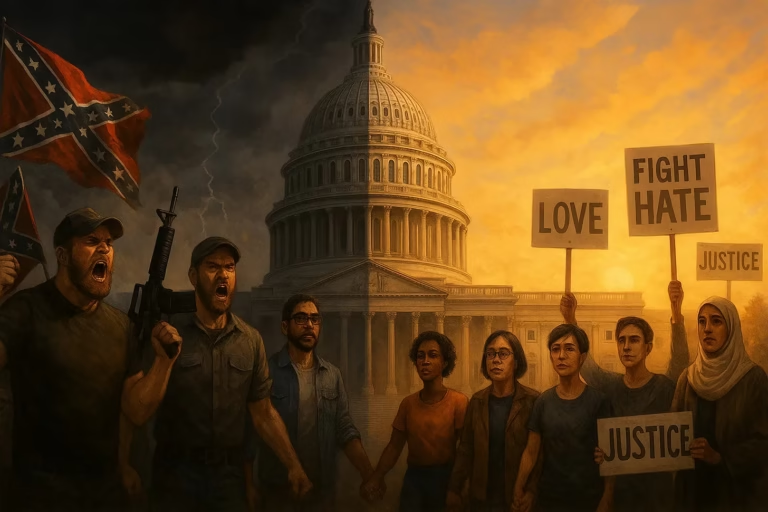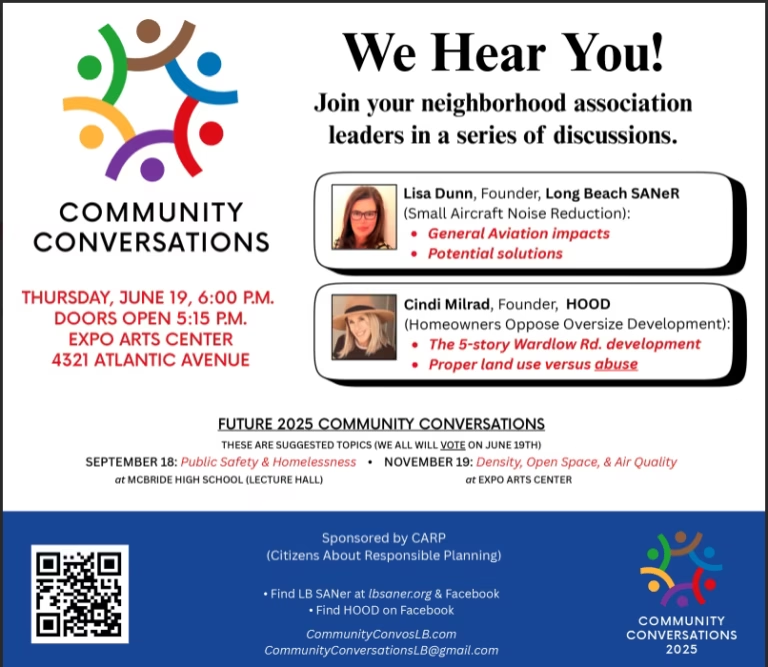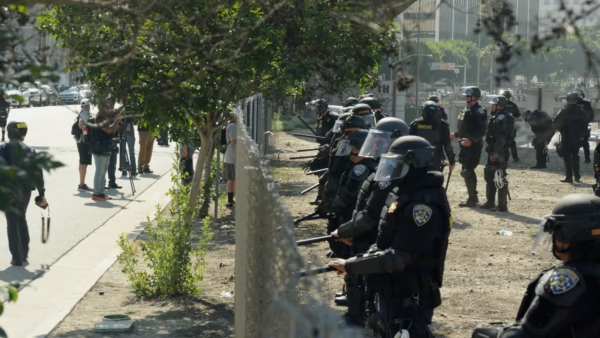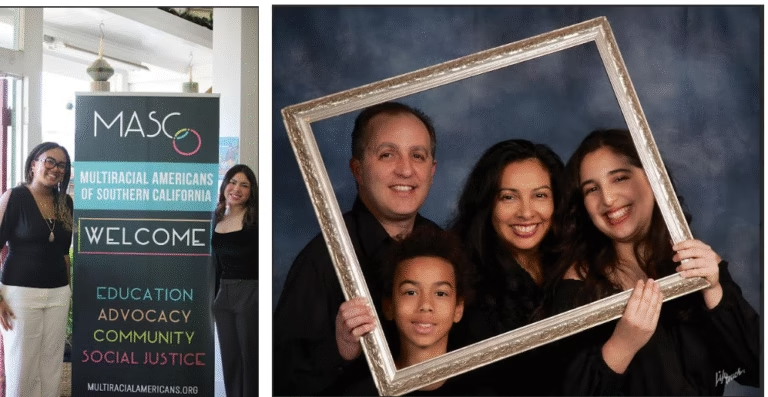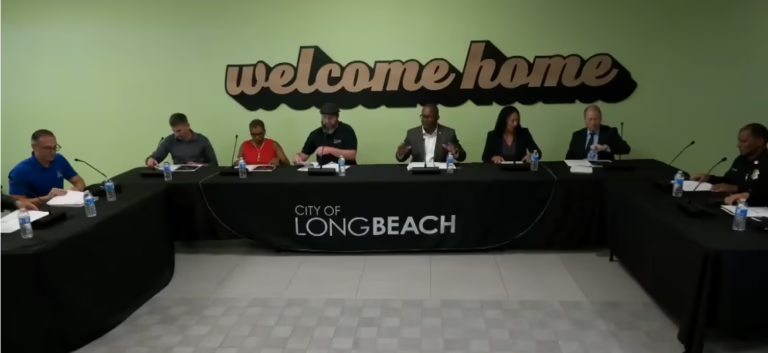Why America must confront the corrosive force that Trump is trying to use to tear us apart…
Yesterday, I spoke with you about the importance of our government embracing free speech and not trying to stifle it or intimidate (or deport) people for unpopular political writings. Today, let’s examine the flip side of that argument: hate speech, the power and danger of hate itself, and how we defeat it as Trump tries to use it to manipulate us.
Hate is poison; it never makes anything better. It’s corrosive like an acid, eats away at our empathy and reason, and eventually destroys our very humanity. When nations are consumed by hate — like Germany was in the 1930s, or the American South was during Jim Crow — the result is invariably the destruction of civil society and its replacement with political, economic, and legal systems based in and dependent upon violence.
Hate killed a state legislator in Minneapolis this past weekend, nearly killed Paul Pelosi with a hammer, and fuels the same violent rage that burned through Charlottesville, stormed the Capitol on January 6th, and has been stalking school board meetings and statehouses across America for the past two decades.
Hate brought Senator Alex Padilla to his knees; does anybody believe that if he’d been white he’d have been dragged out like that and beat to the ground? It inspired Senator Mike Lee and Elon Musk to essentially congratulate a would-be mass murderer. It just arrested the Comptroller of New York City for trying to defend a man seeking asylum in the United States.
Hate blew up the Federal Building in Oklahoma City, took down the twin towers on 9/11, and keeps loading the chambers of mass shooters while whispering lies about enemies and conspiracies until blood spills in schools, synagogues, churches, and supermarkets.
So, why does Trump — and why do his followers, including those elected to federal and state office, and his cabinet members — so vigorously embrace hate?
Trump is the first president in American history to explicitly use hate as a campaign tool and then embrace it as the central focus of his rule. He launched his first campaign by calling Mexicans “rapists,” proposed a Muslim ban, called for violence at his rallies, and used dehumanizing language to describe immigrants, women, and political opponents. For Memorial Day, he posted a social media message calling the half of Americans who voted against him “scum.”
This wasn’t political strategy in the traditional sense — it was a revival of something far more dangerous: the politics of hate as a tool for seizing and maintaining power.
It works, in part, because hate can be intoxicating. It reduces complex issues to simple binaries grounded in scapegoating the hated. Economic anxiety becomes the fault of immigrants. Cultural change becomes a conspiracy by elites. Personal failures become the result of a rigged system designed to benefit “them” at the expense of “us.”
And Trump’s use of hate is unprecedented in American presidential politics. Previous presidents, even those who harbored prejudices or implemented discriminatory policies, worked to maintain a veneer of dignity and unity in their public messaging.
They understood that the presidency — the ultimate parental figure and role model for the nation, its citizens, and its children — demanded a certain moral authority, even when their actions fell short of their rhetoric.
Trump shattered that norm, showing other Republicans that explicit appeals to grievance and animosity — and the amplification of them by rightwing hate-based media — mobilized his base more effectively than traditional appeals to shared values or common purpose.
Why, after all, bother to fix things and make the country run better when you can hold power and massively enrich yourself by simply and constantly churning the rancid pool of hate that’s always deep in the underbelly of any nation?
This has worked for Trump because hate is intoxicating; it provides a rush of righteous anger that feels empowering to those who feel powerless. It creates a sense of belonging among those who’ve been marginalized by 44 years of Reaganism gutting the middle class.
Most dangerously, it absolves the haters of personal responsibility by moving the blame for society’s usually complex problems onto designated enemies like immigrants, trans people, and racial or religious minorities.
Authoritarian leaders throughout history have used hate as a unifying force; indeed, it’s the key to authoritarians seizing power in the first place. When a population is afraid, divided, or economically insecure, hate becomes a shortcut to loyalty.
“It’s not your fault you’re struggling,” the demagogue whispers. “It’s their fault — the Jews, the immigrants, the Blacks, the Muslims, the queer people, the intellectuals, the journalists, the protestors.”
Hate simplifies the world into “us” and “them,” and in doing so it becomes a weapon of distraction that keeps working people too angry at each other to realize they’re being ripped off and exploited by the very people stoking the flames.
That’s exactly what’s happening in America today.
While Trump and the GOP rage about immigrants, trans kids, and university protests, they’re shoveling trillions in tax cuts to billionaires, gutting environmental protections, slashing Social Security and healthcare funding, and selling off public lands to oil and mining companies.
This reinvented GOP — this party of hate — wants you looking at your neighbor with suspicion so you don’t notice the donor class that’s buying your government out from under you. Hate stood in a press conference last week and declared its mission was to “liberate” Los Angeles from its mayor and governor.
But there’s a deeper, psychological layer to this too. Hate feels powerful. It produces adrenaline, a rush of certainty, a sense of purpose. It gives people who feel small and angry a story where they’re not just victims; instead, they’re righteous warriors.
In a society where inequality has exploded because we still haven’t overturned Reagan’s neoliberalism and raised taxes on rich people, hate offers the illusion of control.
And Trump — with his narcissism, his need for revenge, and his boundless craving for applause — knows how to serve that illusion with a smile and a sneer. He doesn’t just deploy hate cynically. He needs it. It’s his fuel. It fills his rallies. It lights up his social media posts. It drives his movement. It’s intrinsic to his personality and has driven him throughout his life.
Tragically for the rest of us, the consequences are very real.
Black churches are being burned again. Jewish people are being murdered in synagogues. Asian American elders are being assaulted in the streets. Hispanic families are being torn apart. Queer teens are dying by suicide. Public servants — from school board members to election workers — are being harassed, threatened, and driven from their posts.
We’ve been here before. The Ku Klux Klan used Christianity and nationalism to justify lynching. Hitler used “traditional values” and economic anxiety to justify genocide. Rwanda’s broadcasters spent months using radio to call their political enemies “cockroaches” before the slaughter began. The pattern is always the same: dehumanize, divide, and destroy.
And it can happen here again — if we let it.
Already we see Republican governors like Ron DeSantis and Greg Abbott rewriting textbooks to whitewash slavery and justify bigotry. We see state legislators introducing laws that would imprison librarians, ban books, silence teachers, erase trans people, and outlaw protest. We see a Supreme Court that’s blessed voter suppression and gutted civil rights law. We see vigilantes armed with AR-15s patrolling polling places and border towns.
And we see a growing movement, led by Trump, that is explicitly preparing for violence. His allies talk about using the military against American citizens. They’re calling for mass deportations, camps, loyalty tests, and the criminalization of dissent.
This isn’t rhetoric. It’s a roadmap.
But hate is also fragile. Its political utility contains the seeds of its own destruction. Societies built on hatred eventually consume themselves: As we’re all experiencing right now, the energy required to maintain constant vigilance against enemies exhausts populations.
The paranoia that fuels hate movements creates internal fractures as former allies become new targets, something we’ve seen repeatedly among Trump’s lieutenants. No society based in hate can last long; just ask the ghosts of the Confederacy.
History provides numerous examples of this pattern. The French Revolution devoured its own children as revolutionary fervor turned to internecine purges. McCarthyism eventually collapsed under the weight of its own excesses. The Cultural Revolution in China destroyed countless lives before the leadership recognized its destructive trajectory. In each case, societies paid tremendous costs before finding ways to step back from the brink.
The antidote to hate isn’t silence or appeasement. It’s not cowardice or cynicism. It’s courage, as we saw this past weekend during the No Kings Day protests.
It’s the courage to speak out, even when your voice shakes. It’s the courage to stand with your neighbors, especially the most vulnerable. It’s the courage to vote, to organize, to protest, and to tell the truth about the haters, even when the truth is unpopular and the haters threaten you.
America is not a perfect country. But we are a country with a long tradition of fighting back against hate, from the abolitionists to the Freedom Riders, from labor organizers to marriage equality activists. Every inch of progress this nation has seen over the past 250 years has come from people refusing to let hatred have the last word.
Now it’s our turn to confront and defeat hate. Our opportunity to remake America with compassion and the embrace of our fellow human beings, regardless of their race, religion, gender identity, or politics. It’s our obligation in this new century that’s been so badly despoiled by Trump’s pathetic attempts to turn us against each other.
Trump is betting that Americans are too numb, too tired, or too divided to stand up to the hate machine he’s building. He’s betting that we’ll be distracted by his and Fox’s manufactured outrage while he consolidates power behind the scenes.
But we can prove him wrong. We can show up — in the streets, at the ballot box, in our neighborhoods and online communities — and remind each other that decency still matters, that democracy still matters, that love and solidarity are stronger than hate and fear.
Our Founders remind us that this great country belongs to the people. All of us. United not by race or religion or ideology, but by a shared commitment to democracy, liberty, and justice for everyone.
Let’s make that commitment real. Let’s reject hate. Let’s choose courage. And let’s fight like hell for the America we still believe is possible.
Pass it along, speak out, and get active; tag, you’re it!



